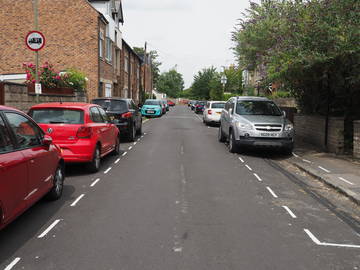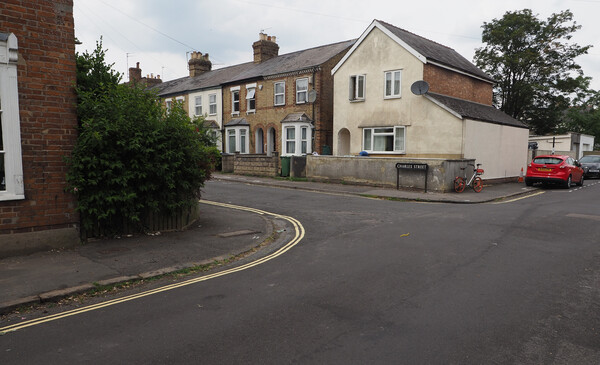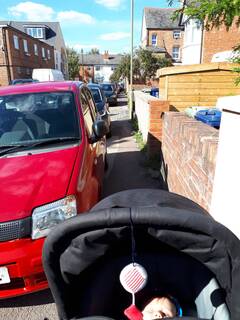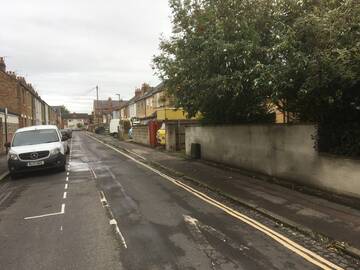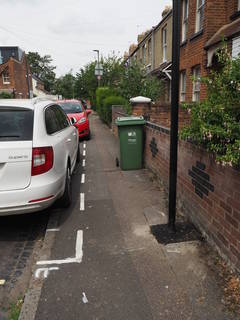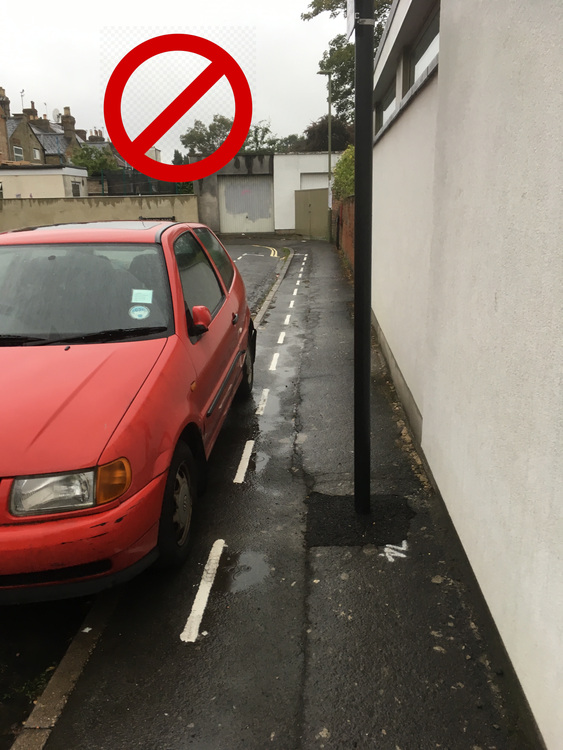The area we're in has recently been made a controlled parking zone, meaning that only vehicles with an area permit can park in it. Residents have to pay £60/year for a permit, with a maximum of two per house, and get a set of one-day vouchers for use by visitors or tradespeople. Unlike the Iffley Fields area, just across Iffley Rd, our area has explicitly marked parking spaces, as in the photo to the right. Mostly this has just formalised the pre-existing parking, but there are some significant changes.
The £60/year is not a payment for the space, or a source of revenue for the council, but goes entirely to fund enforcement of parking restrictions within the zone, which was previously pretty much non-existent. This is one gain from the scheme.
the good
To my mind the best bit of the new scheme — and something I specifically asked for in the consultation — are the new double yellow lines on corners. These greatly improve visibility at junctions, and thus make both walking and cycling safer. They also improve physical accessibility for people trying to cross the road, though some coordinated dropped kerbs would help there. And they improve clearance for turning vehicles, notably for garbage trucks.
In some places, new parking restrictions (and enforcement of existing ones) have freed up footpaths. The eastern footpath on the northern stretch of Catherine St, for example, used to be impassable to anyone pushing a buggy as a result of cars and vans parked on the pavement — now the entire stretch is double-yellowed.
In some places parking has been expanded but, largely because of the double-yellowing of corners, there has clearly been an overall reduction in parking.
More fundamentally, the switch from "anyone can park wherever they like, unless prohibited" to "you need a permit to park, and can only park in designated areas" is critical. It opens up the possibility of a genuine fee for parking, perhaps in the form of some kind of "green tax" based on vehicle size and pollution. Or a commitment by the council to reduce the number of permits handed out each year (with a waiting list).
the ok
It was unclear to me what effect the scheme would have on finding parking. Our house is some distance from any commercial areas or bus stops, or other plausible park-and-work or park-and-ride destinations, and the pressure on parking was greatest in the evenings rather than in the daytime. So I wasn't expecting the scheme to change this — indeed I thought it might make it harder to find parking, given the reduction in parking places.
But it is actually easier to park in the evenings now, so there must be fewer cars stored on the streets overnight. Some people appear to be using off-street parking where they weren't previously, presumably to avoid paying for a permit, but that's only an option for a small number of households (the photo of Catherine St above is atypical). Quite likely a number of the cars previously parked in the area were owned by students living in university accommodation, who aren't entitled to parking permits. (On top of existing student housing, a newly built block housing 135 students is just about to open.) Possibly some people have given up cars. There are no baseline figures on this, but we'll now know exactly how many permits are issued every year and can track future changes.
It would be interesting to see if local traffic has reduced. Howard St carries mostly through traffic, but there were some one-off counts on e.g. Catherine St that it would be interesting to repeat. Probably this is swamped by other factors, though, and not affected much by a small decrease in parking availability.
the horrible
The worst bit of the scheme is something I hadn't considered, which is the need for poles to hold the signs stating the parking restrictions. In many places these are a nasty intrusion into footpath space.
The example on the left is not so bad — the bin visible behind it is a worse obstacle, though not a permanent one — but the second one, on Barnet St, leaves only a 60cm gap to the marked parking place! This is simply not acceptable.
As with electric vehicle charging points, if signage can't be put on fences or walls or incorporated into existing street furniture, it should really be on poles on build-outs into the carriageway. It can't make footpaths unusable by wheelchairs or prams.

